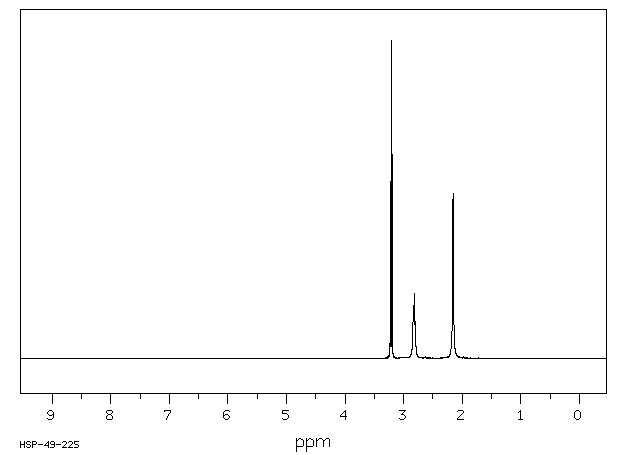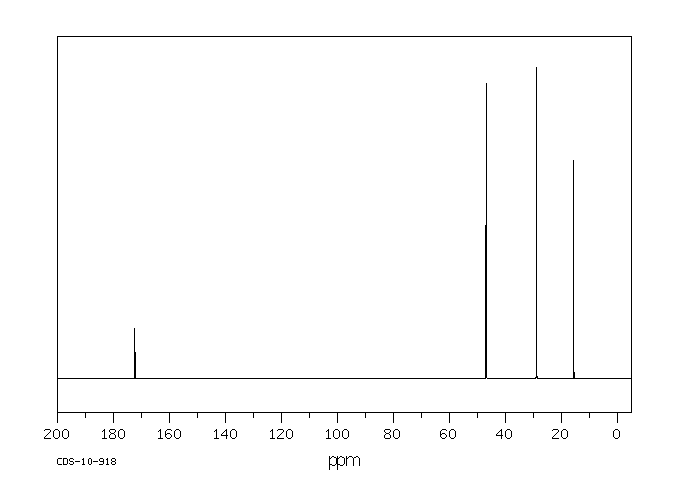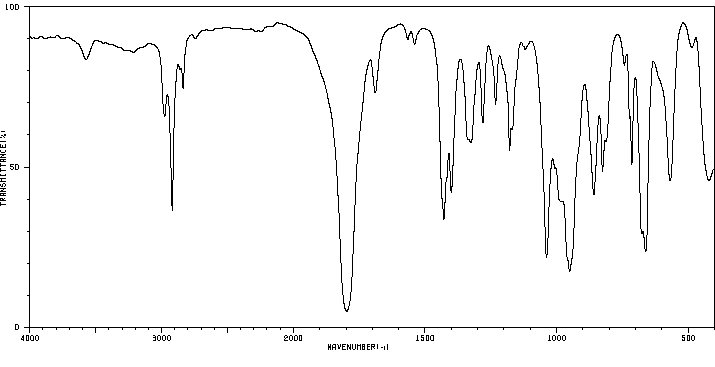3-甲硫基丙酰氯 | 7031-23-4
中文名称
3-甲硫基丙酰氯
中文别名
3-甲基硫代丙酰氯;3-(甲硫基)丙酰氯
英文名称
3-(methylthio)propionyl chloride
英文别名
3-(methylthio)propanoyl chloride;3-(methylsulfanyl)propanoyl chloride;3-(methylsulfanyl)propionyl chloride;3-Methylthiopropionic acid chloride;3-methylsulfanylpropanoyl chloride
CAS
7031-23-4
化学式
C4H7ClOS
mdl
——
分子量
138.618
InChiKey
NRHMXMBVLXSSAX-UHFFFAOYSA-N
BEILSTEIN
——
EINECS
——
-
物化性质
-
计算性质
-
ADMET
-
安全信息
-
SDS
-
制备方法与用途
-
上下游信息
-
文献信息
-
表征谱图
-
同类化合物
-
相关功能分类
-
相关结构分类
物化性质
-
沸点:96 °C / 37mmHg
-
密度:1,2 g/cm3
计算性质
-
辛醇/水分配系数(LogP):1.4
-
重原子数:7
-
可旋转键数:3
-
环数:0.0
-
sp3杂化的碳原子比例:0.75
-
拓扑面积:42.4
-
氢给体数:0
-
氢受体数:2
安全信息
-
危险等级:8
-
安全说明:S16,S26,S36/37/39
-
危险类别码:R11
-
海关编码:2930909090
-
危险品运输编号:UN 2924
-
储存条件:存放于惰性气体中,并避免接触湿气(否则可能发生分解)。
SDS
3-(Methylthio)propionyl Chloride Revision number: 5
SAFETY DATA SHEET
Section 1. IDENTIFICATION
Product name: 3-(Methylthio)propionyl Chloride
Revision number: 5
Section 2. HAZARDS IDENTIFICATION
GHS classification
PHYSICAL HAZARDS
Category 4
Flammable liquids
HEALTH HAZARDS
Category 1B
Skin corrosion/irritation
Serious eye damage/eye irritation Category 1
Not classified
ENVIRONMENTAL HAZARDS
GHS label elements, including precautionary statements
Pictograms or hazard symbols
Signal word Danger
Hazard statements Combustible liquid
Causes severe skin burns and eye damage
Precautionary statements:
[Prevention] Keep away from flames and hot surfaces.
Do not breathe dust/fume/gas/mist/vapours/spray.
Wash hands thoroughly after handling.
Wear protective gloves and eye/face protection.
[Response] IF INHALED: Remove victim to fresh air and keep at rest in a position comfortable for
breathing.
IF SWALLOWED: Rinse mouth. Do NOT induce vomiting.
IF IN EYES: Rinse cautiously with water for several minutes. Remove contact lenses,
if present and easy to do. Continue rinsing.
IF ON SKIN (or hair): Remove/Take off immediately all contaminated clothing. Rinse
skin with water/shower.
Wash contaminated clothing before reuse.
Immediately call a POISON CENTER or doctor/physician.
[Storage] Store in a well-ventilated place. Keep cool.
Store locked up.
[Disposal] Dispose of contents/container through a waste management company authorized by
the local government.
3-(Methylthio)propionyl Chloride
Section 3. COMPOSITION/INFORMATION ON INGREDIENTS
Substance/mixture: Substance
Components: 3-(Methylthio)propionyl Chloride
Percent: >98.0%(T)
CAS Number: 7031-23-4
Synonyms: 3-(Methylmercapto)propionyl Chloride
Chemical Formula: C4H7ClOS
Section 4. FIRST AID MEASURES
Remove victim to fresh air and keep at rest in a position comfortable for breathing.
Inhalation:
Immediately call a POISON CENTER or doctor/physician.
Skin contact: Remove/Take off immediately all contaminated clothing. Gently wash with plenty of
soap and water. Immediately call a POISON CENTER or doctor/physician.
Eye contact: Rinse cautiously with water for several minutes. Remove contact lenses, if present
and easy to do. Continue rinsing.Immediately call a POISON CENTER or
doctor/physician.
Ingestion: Immediately call a POISON CENTER or doctor/physician. Rinse mouth. Do NOT
induce vomiting.
A rescuer should wear personal protective equipment, such as rubber gloves and air-
Protection of first-aiders:
tight goggles.
Section 5. FIRE-FIGHTING MEASURES
Suitable extinguishing Dry chemical, carbon dioxide.
media:
Unsuitable extinguishing Water
media:
Specific hazards arising Take care as it may decompose upon combustion or in high temperatures to
from the chemical: generate poisonous fume.
Precautions for firefighters: Fire-extinguishing work is done from the windward and the suitable fire-extinguishing
method according to the surrounding situation is used. Uninvolved persons should
evacuate to a safe place. In case of fire in the surroundings: Remove movable
containers if safe to do so.
Special protective When extinguishing fire, be sure to wear personal protective equipment.
equipment for firefighters:
Section 6. ACCIDENTAL RELEASE MEASURES
Personal precautions, Use extra personal protective equipment (self-contained breathing apparatus). Keep
protective equipment and people away from and upwind of spill/leak. Ensure adequate ventilation. Entry to non-
emergency procedures: involved personnel should be controlled around the leakage area by roping off, etc.
Environmental precautions: Prevent product from entering drains.
Methods and materials for Absorb spilled material in a suitable absorbent (e.g. rag, dry sand, earth, saw-dust).
containment and cleaning In case of large amount of spillage, contain a spill by bunding. Adhered or collected
up: material should be promptly disposed of, in accordance with appropriate laws and
regulations.
Prevention of secondary Do not allow contact with water. Remove all sources of ignition. Fire-extinguishing
hazards: devices should be prepared in case of a fire. Use spark-proof tools and explosion-
proof equipment.
Section 7. HANDLING AND STORAGE
Precautions for safe handling
Technical measures: Handling is performed in a well ventilated place. Wear suitable protective equipment.
Prevent generation of vapour or mist. Keep away from flames and hot surfaces. Take
measures to prevent the build up of electrostatic charge. Use explosion-proof
equipment. Wash hands and face thoroughly after handling.
Use a closed system, ventilation.
Advice on safe handling: Avoid contact with skin, eyes and clothing.
May develop pressure. Open carefully.
3-(Methylthio)propionyl Chloride
Section 7. HANDLING AND STORAGE
Conditions for safe storage, including any
incompatibilities
Storage conditions: Keep container tightly closed. Store in a cool, dark and well-ventilated place.
Store under inert gas.
Protect from moisture.
Store locked up.
Store away from incompatible materials such as oxidizing agents.
Moisture-sensitive
Packaging material: Comply with laws.
Section 8. EXPOSURE CONTROLS / PERSONAL PROTECTION
Engineering controls: Install a closed system or local exhaust. Also install safety shower and eye bath.
Personal protective equipment
Respiratory protection: Half or full facepiece respirator, self-contained breathing apparatus(SCBA), supplied
air respirator, etc. Use respirators approved under appropriate government standards
and follow local and national regulations.
Impervious gloves.
Hand protection:
Eye protection: Safety goggles. A face-shield, if the situation requires.
Skin and body protection: Impervious protective clothing. Protective boots, if the situation requires.
Section 9. PHYSICAL AND CHEMICAL PROPERTIES
Physical state (20°C): Liquid
Form: Clear
Colorless - Slightly pale yellow
Colour:
Odour: No data available
pH: No data available
Melting point/freezing point:No data available
96°C/4.9kPa
Boiling point/range:
Flash point: No data available
Flammability or explosive
limits:
No data available
Lower:
Upper: No data available
1.20
Relative density:
Solubility(ies):
No data available
[Water]
[Other solvents] No data available
Section 10. STABILITY AND REACTIVITY
Chemical stability: Stable under proper conditions.
Possibility of hazardous Decomposes in contact with water and liberates toxic gases.
reactions:
Conditions to avoid: Open flame, Moisture
Incompatible materials: Oxidizing agents, Bases
Hazardous decomposition Carbon monoxide, Carbon dioxide, Sulfur oxides, Hydrogen chloride
products:
Section 11. TOXICOLOGICAL INFORMATION
No data available
Acute Toxicity:
Skin corrosion/irritation: No data available
No data available
Serious eye
damage/irritation:
Germ cell mutagenicity: No data available
Carcinogenicity:
No data available
IARC =
NTP = No data available
3-(Methylthio)propionyl Chloride
Section 11. TOXICOLOGICAL INFORMATION
Reproductive toxicity: No data available
Section 12. ECOLOGICAL INFORMATION
Ecotoxicity:
Fish: No data available
Crustacea: No data available
Algae: No data available
Persistence / degradability: No data available
No data available
Bioaccumulative
potential(BCF):
Mobility in soil
Log Pow: No data available
Soil adsorption (Koc): No data available
Henry's Law No data available
constant(PaM3/mol):
Section 13. DISPOSAL CONSIDERATIONS
Recycle to process, if possible. Consult your local regional authorities. You may be able to burn in a chemical
incinerator equipped with an afterburner and scrubber system. Observe all federal, state and local regulations when
disposing of the substance.
Section 14. TRANSPORT INFORMATION
Hazards Class: 8: Corrosive.
UN-No: 3265
Proper shipping name: Corrosive liquid, acidic, organic, n.o.s.
Packing group: II
Section 15. REGULATORY INFORMATION
Safe management ordinance of dangerous chemical product (State Council announces on January 26, 2002
and revised on February 16,2011): Safe use and production, the storage of a dangerous chemical, transport,
loading and unloading were prescribed.
SECTION 16 - ADDITIONAL INFORMATION
N/A
SAFETY DATA SHEET
Section 1. IDENTIFICATION
Product name: 3-(Methylthio)propionyl Chloride
Revision number: 5
Section 2. HAZARDS IDENTIFICATION
GHS classification
PHYSICAL HAZARDS
Category 4
Flammable liquids
HEALTH HAZARDS
Category 1B
Skin corrosion/irritation
Serious eye damage/eye irritation Category 1
Not classified
ENVIRONMENTAL HAZARDS
GHS label elements, including precautionary statements
Pictograms or hazard symbols
Signal word Danger
Hazard statements Combustible liquid
Causes severe skin burns and eye damage
Precautionary statements:
[Prevention] Keep away from flames and hot surfaces.
Do not breathe dust/fume/gas/mist/vapours/spray.
Wash hands thoroughly after handling.
Wear protective gloves and eye/face protection.
[Response] IF INHALED: Remove victim to fresh air and keep at rest in a position comfortable for
breathing.
IF SWALLOWED: Rinse mouth. Do NOT induce vomiting.
IF IN EYES: Rinse cautiously with water for several minutes. Remove contact lenses,
if present and easy to do. Continue rinsing.
IF ON SKIN (or hair): Remove/Take off immediately all contaminated clothing. Rinse
skin with water/shower.
Wash contaminated clothing before reuse.
Immediately call a POISON CENTER or doctor/physician.
[Storage] Store in a well-ventilated place. Keep cool.
Store locked up.
[Disposal] Dispose of contents/container through a waste management company authorized by
the local government.
3-(Methylthio)propionyl Chloride
Section 3. COMPOSITION/INFORMATION ON INGREDIENTS
Substance/mixture: Substance
Components: 3-(Methylthio)propionyl Chloride
Percent: >98.0%(T)
CAS Number: 7031-23-4
Synonyms: 3-(Methylmercapto)propionyl Chloride
Chemical Formula: C4H7ClOS
Section 4. FIRST AID MEASURES
Remove victim to fresh air and keep at rest in a position comfortable for breathing.
Inhalation:
Immediately call a POISON CENTER or doctor/physician.
Skin contact: Remove/Take off immediately all contaminated clothing. Gently wash with plenty of
soap and water. Immediately call a POISON CENTER or doctor/physician.
Eye contact: Rinse cautiously with water for several minutes. Remove contact lenses, if present
and easy to do. Continue rinsing.Immediately call a POISON CENTER or
doctor/physician.
Ingestion: Immediately call a POISON CENTER or doctor/physician. Rinse mouth. Do NOT
induce vomiting.
A rescuer should wear personal protective equipment, such as rubber gloves and air-
Protection of first-aiders:
tight goggles.
Section 5. FIRE-FIGHTING MEASURES
Suitable extinguishing Dry chemical, carbon dioxide.
media:
Unsuitable extinguishing Water
media:
Specific hazards arising Take care as it may decompose upon combustion or in high temperatures to
from the chemical: generate poisonous fume.
Precautions for firefighters: Fire-extinguishing work is done from the windward and the suitable fire-extinguishing
method according to the surrounding situation is used. Uninvolved persons should
evacuate to a safe place. In case of fire in the surroundings: Remove movable
containers if safe to do so.
Special protective When extinguishing fire, be sure to wear personal protective equipment.
equipment for firefighters:
Section 6. ACCIDENTAL RELEASE MEASURES
Personal precautions, Use extra personal protective equipment (self-contained breathing apparatus). Keep
protective equipment and people away from and upwind of spill/leak. Ensure adequate ventilation. Entry to non-
emergency procedures: involved personnel should be controlled around the leakage area by roping off, etc.
Environmental precautions: Prevent product from entering drains.
Methods and materials for Absorb spilled material in a suitable absorbent (e.g. rag, dry sand, earth, saw-dust).
containment and cleaning In case of large amount of spillage, contain a spill by bunding. Adhered or collected
up: material should be promptly disposed of, in accordance with appropriate laws and
regulations.
Prevention of secondary Do not allow contact with water. Remove all sources of ignition. Fire-extinguishing
hazards: devices should be prepared in case of a fire. Use spark-proof tools and explosion-
proof equipment.
Section 7. HANDLING AND STORAGE
Precautions for safe handling
Technical measures: Handling is performed in a well ventilated place. Wear suitable protective equipment.
Prevent generation of vapour or mist. Keep away from flames and hot surfaces. Take
measures to prevent the build up of electrostatic charge. Use explosion-proof
equipment. Wash hands and face thoroughly after handling.
Use a closed system, ventilation.
Advice on safe handling: Avoid contact with skin, eyes and clothing.
May develop pressure. Open carefully.
3-(Methylthio)propionyl Chloride
Section 7. HANDLING AND STORAGE
Conditions for safe storage, including any
incompatibilities
Storage conditions: Keep container tightly closed. Store in a cool, dark and well-ventilated place.
Store under inert gas.
Protect from moisture.
Store locked up.
Store away from incompatible materials such as oxidizing agents.
Moisture-sensitive
Packaging material: Comply with laws.
Section 8. EXPOSURE CONTROLS / PERSONAL PROTECTION
Engineering controls: Install a closed system or local exhaust. Also install safety shower and eye bath.
Personal protective equipment
Respiratory protection: Half or full facepiece respirator, self-contained breathing apparatus(SCBA), supplied
air respirator, etc. Use respirators approved under appropriate government standards
and follow local and national regulations.
Impervious gloves.
Hand protection:
Eye protection: Safety goggles. A face-shield, if the situation requires.
Skin and body protection: Impervious protective clothing. Protective boots, if the situation requires.
Section 9. PHYSICAL AND CHEMICAL PROPERTIES
Physical state (20°C): Liquid
Form: Clear
Colorless - Slightly pale yellow
Colour:
Odour: No data available
pH: No data available
Melting point/freezing point:No data available
96°C/4.9kPa
Boiling point/range:
Flash point: No data available
Flammability or explosive
limits:
No data available
Lower:
Upper: No data available
1.20
Relative density:
Solubility(ies):
No data available
[Water]
[Other solvents] No data available
Section 10. STABILITY AND REACTIVITY
Chemical stability: Stable under proper conditions.
Possibility of hazardous Decomposes in contact with water and liberates toxic gases.
reactions:
Conditions to avoid: Open flame, Moisture
Incompatible materials: Oxidizing agents, Bases
Hazardous decomposition Carbon monoxide, Carbon dioxide, Sulfur oxides, Hydrogen chloride
products:
Section 11. TOXICOLOGICAL INFORMATION
No data available
Acute Toxicity:
Skin corrosion/irritation: No data available
No data available
Serious eye
damage/irritation:
Germ cell mutagenicity: No data available
Carcinogenicity:
No data available
IARC =
NTP = No data available
3-(Methylthio)propionyl Chloride
Section 11. TOXICOLOGICAL INFORMATION
Reproductive toxicity: No data available
Section 12. ECOLOGICAL INFORMATION
Ecotoxicity:
Fish: No data available
Crustacea: No data available
Algae: No data available
Persistence / degradability: No data available
No data available
Bioaccumulative
potential(BCF):
Mobility in soil
Log Pow: No data available
Soil adsorption (Koc): No data available
Henry's Law No data available
constant(PaM3/mol):
Section 13. DISPOSAL CONSIDERATIONS
Recycle to process, if possible. Consult your local regional authorities. You may be able to burn in a chemical
incinerator equipped with an afterburner and scrubber system. Observe all federal, state and local regulations when
disposing of the substance.
Section 14. TRANSPORT INFORMATION
Hazards Class: 8: Corrosive.
UN-No: 3265
Proper shipping name: Corrosive liquid, acidic, organic, n.o.s.
Packing group: II
Section 15. REGULATORY INFORMATION
Safe management ordinance of dangerous chemical product (State Council announces on January 26, 2002
and revised on February 16,2011): Safe use and production, the storage of a dangerous chemical, transport,
loading and unloading were prescribed.
SECTION 16 - ADDITIONAL INFORMATION
N/A
反应信息
-
作为反应物:描述:3-甲硫基丙酰氯 在 zinc(II) fluoride 作用下, 以60%的产率得到β-methylthiopropionyl fluoride参考文献:名称:Reaction of β-alkylthiopropionyl tetrafluoroborates with alkenes摘要:The reaction of beta-alkylthiopropionyl tetrafluoroborates with alkenes results in formation of 6-membered cyclic sulfonium salts. Succeeding cleavage of sulfonium salts by bases affords the corresponding 5-alkythiopent-1-en-3-ones.DOI:10.1016/0040-4039(95)01220-c
-
作为产物:描述:参考文献:名称:不对称转移氢化是合成氨基羧酸膦酸类似物的关键步骤摘要:17 α-氧代膦酸二异丙酯的不对称转移氢化(ATH)是通过使用市售的Noyori型催化剂完成的。高度对映体富集的产物(除了一种情况外,在所有情况下ee > 98%)进一步转化为 15 种氨基羧酸的膦酸类似物。所建立的方法也可用于起始α-氧代膦酸酯的不对称转移氘代(ATD)。DOI:10.1002/chem.202302171
文献信息
-
Live-Cell Protein Modification by Boronate-Assisted Hydroxamic Acid Catalysis作者:Christopher Adamson、Hidetoshi Kajino、Shigehiro A. Kawashima、Kenzo Yamatsugu、Motomu KanaiDOI:10.1021/jacs.1c07060日期:2021.9.22Selective methods for introducing protein post-translational modifications (PTMs) within living cells have proven valuable for interrogating their biological function. In contrast to enzymatic methods, abiotic catalysis should offer access to diverse and new-to-nature PTMs. Herein, we report the boronate-assisted hydroxamic acid (BAHA) catalyst system, which comprises a protein ligand, a hydroxamic在活细胞中引入蛋白质翻译后修饰 (PTM) 的选择性方法已被证明对研究其生物学功能很有价值。与酶法相比,非生物催化应该提供对各种新自然 PTM 的访问。在此,我们报道了硼酸盐辅助的异羟肟酸(BAHA)催化剂体系,该体系由蛋白质配体、异羟肟酸路易斯碱和二醇部分组成。与带有硼酸的酰基供体配合,我们的催化剂利用局部摩尔浓度效应来促进酰基转移到目标赖氨酸残基。我们的催化剂系统采用微摩尔浓度的试剂,并提供最小的脱靶蛋白反应性。至关重要的是,BAHA 对谷胱甘肽具有抗性,谷胱甘肽是一种阻碍活细胞内非生物化学的许多努力的代谢物。在人体细胞中表达的大肠杆菌二氢叶酸还原酶。我们的结果进一步确立了众所周知的硼酸-二醇络合作为真正的生物正交反应,在化学生物学和细胞内催化中的应用。
-
PYRAZOLE COMPOUNDS AND USE THEREOF申请人:Takagi Masaki公开号:US20090036450A1公开(公告)日:2009-02-05The pyrazole compound of the present invention is represented by the following general formula (I). The pyrazole compound of the present invention or a salt thereof or a solvate thereof potently inhibits liver glycogen phosphorylase, and, therefore, is useful as a therapeutic or prophylactic agent for diabetes. wherein each symbol denotes as described in the specifications.
-
Sequential Multicomponent Synthesis of 2-(Imidazo[1,5-α]pyridin-1-yl)-1,3,4-Oxadiazoles作者:Santosh Kurhade、Markella Konstantinidou、Fandi Sutanto、Katarzyna Kurpiewska、Justyna Kalinowska-Tłuścik、Alexander DömlingDOI:10.1002/ejoc.201801880日期:2019.3.14A 21 membered library of 2-(imidazo[1,5-alpha]pyridine-1-yl)-1,3,4-oxadiazoles is synthesized in an unprecedented short sequence starting from an Ugi tetrazole reaction with a cleavable isocyanide component. The intermediate tetrazole is subjected to an acetic anhydride-mediated cyclization, followed by a Huisgen-type rearrangement with acyl chlorides to afford the imidazopyridine-oxadiazole bis-heterocycles
-
PESTICIDAL COMPOSITIONS AND PROCESSES RELATED THERETO申请人:Dow AgroSciences LLC公开号:US20130109566A1公开(公告)日:2013-05-02This document discloses molecules having the following formula (“Formula One”): and processes related thereto.这份文件公开了具有以下公式(“公式一”)的分子以及与之相关的过程。
-
[EN] FUSED PYRIMIDINE PYRIDINONE COMPOUNDS AS JAK INHIBITORS<br/>[FR] COMPOSÉS DE PYRIMIDINE PYRIDINONE FUSIONNÉS EN TANT QU'INHIBITEURS DE JAK申请人:THERAVANCE BIOPHARMA R&D IP LLC公开号:WO2021108803A1公开(公告)日:2021-06-03The disclosure provides compounds of formula (I), or a pharmaceutically-acceptable salt thereof, wherein the variables are defined in the specification, that are inhibitors of JAK kinases, particularly JAK3. The disclosure also provides pharmaceutical compositions comprising such compounds, and methods of using such compounds to treat gastrointestinal inflammatory diseases.本公开提供了公式(I)的化合物,或其药用可接受的盐,其中变量如说明书中所定义,这些化合物是JAK激酶的抑制剂,特别是JAK3。本公开还提供了包含这些化合物的药物组合物,以及使用这些化合物治疗胃肠道炎症性疾病的方法。
表征谱图
-
氢谱1HNMR
-
质谱MS
-
碳谱13CNMR
-
红外IR
-
拉曼Raman
-
峰位数据
-
峰位匹配
-
表征信息
同类化合物
顺式-六氢-3a(1H)-并环戊二烯羰基氯化物
金刚烷酰氯
辛酰溴
辛酰氯
辛酰氟
辛-5t-烯酰氯
衣康酰氯
螺[3.5]壬烷-2-甲酰氯
螺[3.4]辛烷-2-甲酰氯
草酰溴
草酰氯
草酰氟
花生酰氯
花生四烯酰氯
肉豆蔻酰氯
肉豆蔻酰-1-13C氯
癸酰氯
癸基二酰二氯
癸二酰氯
異丁醯溴
甲酰氯
甲酰基溴化物
甲氧基乙酰氯
甲基丙烯酰氯
甲基丙烯酰氟
环辛烷羰基氯化物
环戊烷羰基溴
环戊烷羰基氟
环戊基甲酰氯
环戊基乙酰氯
环戊基乙酰氯
环庚烷羰酰氯
环己酰溴
环己甲酰氯
环己基乙酰氯
环己-3-烯-1-甲酰氯
环丙烷乙酰氯
环丙烷丙酰氯
环丁烷羰基碘化物
环丁烷羰基溴化物
环丁烷-1,2-二甲酰氯
环丁基甲酰氯
溴二氯乙酰氯
溴乙酰溴
溴乙酰氯
溴(二氟)乙酰氯
油酰氯
氰基乙酰溴
氯碘乙酰氯
氯氟乙酰氟










